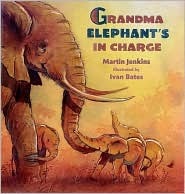
BOOK REVIEW & EXAMPLES OF STUDENT RESPONSES
Grandma Elephant is in Charge (Jenkins, 2014) is one of my favorite informational books to read aloud in the primary grades and it’s back in print! A great way to start the year and begin asking students to draw, label, and write in response to “What did you learn about the grandma elephant?” or “How is the grandma elephant in charge?” Below are some responses from kindergarten students written after I read this aloud and asked them to respond to the prompt, “What did you learn?”
Jenkins’ text makes for a lively, interactive read aloud. He builds up to the introduction of the matriarch by describing the baby elephants’ playfulness and the role of the mother elephants. Then he writes, “But that’s not all. The most important member of an elephant family is…(turn the page) Grandma!” There is a conversation-like tone to the text that describes the role of the grandmother and then there is text (in a different font) that is a series of smaller print – captions? – that provide additional facts like “Elephants can live for up to sixty-five years but don’t usually have any more babies once they’re older than fifty or so.” You could read aloud just the non-narrative text about the grandmother and then go back and read the additional facts or integrate both in the initial read aloud. I think another draw of this text for students is that most can relate to the importance of mothers and grandmothers in their lives. Jenkins’ does not make this connection and I don’t think it’s critical to understanding the book – but I think in many students’ minds it’s there.
My suggestion would be to read aloud this book and just have fun with it. Then maybe read it aloud again and ask the students to think about what they are learning. Give them a specific prompt. Provide opportunities at points in the text to turn and talk with a partner about what they have learned. Then provide time to draw, label, write in response. This activity allows for students to respond at their level of writing/spelling development as you’ll notice in the responses below. Conferring one-to-one with students provides an opportunity for you to take dictation, but also to push students to a higher level of response.
Below I’ve provided a brief analysis of the responses and they inform my follow-up teaching.
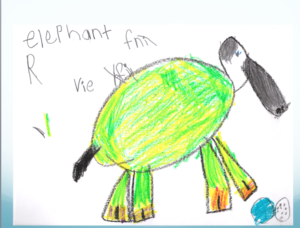
“Elephants are very fun”
This student is taking risks. The student probably used a piece of text in the classroom to spell elephant – effective problem solving. Very much at the “I like” stage of writing (as far as content). The sketch includes some great details -but the parts of the elephant’s body were not a focus of the book. Would work with this student on including more details – whether in writing or sketching about what he or she learned specifically from the text.
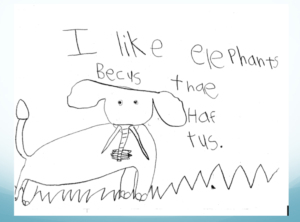
“I like elephants because they have tusks.”
Notice this student has a fact about the elephant – “they have tusks” and a very detailed sketch of the tusk. This is great!!! In future lessons or writing conferences, I’d encourage the student to also include details he learned from the text. (That’s a teaching objective I can draw from this formative assessment.) Tusks were not mentioned in the book. He or she might have learned this by looking at the illustrations in Jenkins’ book, but more likely, the child probably drew from background knowledge.
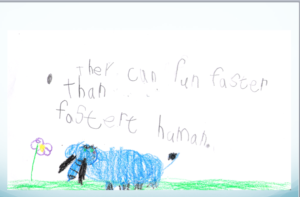
“They can run faster than fastest human.”
This was a fact stated in one of the captions in the book. The idea of the elephant being able to run fast supports the key detail in the book that the grandmother elephant is dangerous when she charges when there’s a sign of danger. This student has written his or her response as a non-narrative fact. This is where we might want to head with other students. “What’s a fact you learned from this text?” or “What’s a fact you learned about how the grandma elephant is in charge?” I gave this lesson many years ago – before Common Core. Now I might reconsider my initial prompt of “What did you learn?” and nuance it a bit to scaffold students’ understanding of how to respond.
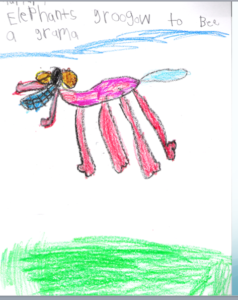
“Elephants grow to be grandma”
One last one for fun. This student has made an assumption. The text does not talk about how the matriarch reaches this status. Nonetheless…there’s some higher level thinking going on here and maybe a reason for “further research.”
The trick in moving primary grade students forward is to engage them in writing responses multiple times to texts read aloud over time. And to use their responses as formative assessments for determining what you need to focus on in your future prompts and conversations with students. A tip is to put students’ work on the document camera and share the strengths of their responses (not the weaknesses) or engage students in “noticing” the strengths of their peers’ responses. Strengths might include – you can tell the picture is of an elephant, the student included a fact, the student wrote in a sentence, the student started with capitalization and ended with punctuation, the student used labels, the student spelled sight words correctly, the students used the sounds (or initial sound) in a word to help him spell the word (which means it may have been correct or not) and so forth. This inspires the students whose work you share and their peers while also providing models for how they might respond.
Okay…I know I always write this at the end of a blog, but I really do hope this helps.
Sunday
